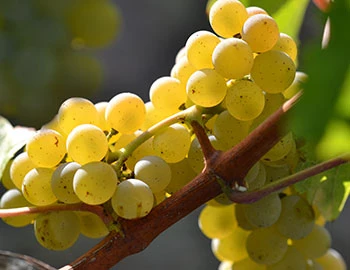
Sancerre Chêne Marchand 2021
AC, S. Fargette & G. Guillerault, 750 ml

| Grape variety: | Sauvignon Blanc |
| Producer: | G. & J. Guillerault / Sebastian Fargette |
| Origin: | France / Loire / Coeur-de-France |
Description
Aromas of ripe yellow fruits and the lush scents of white flowers such as elderberry already seduce on the nose. On the palate, this Sancerre presents itself opulently with a beautiful complexity and broadness. The juicy acidity and light extract sweetness make this wine lively and a good food companion. The grapes for this Sancerre come from the famous Chêne Marchand vineyard in the commune of Bué.
Attributes
| Origin: | France / Loire / Coeur-de-France |
| Grape variety: | Sauvignon Blanc |
| Ripening potential: | 3 to 10 years |
| Drinking temperature: | 10 to 12 °C |
| Food Pairing: | Italian antipasti, Asparagus specialities, Sushi, Sashimi, Ceviche |
| Vinification: | soft pressing, fermentation at low temperatures |
| Harvest: | hand-picking |
| Maturation: | long cultivation, on the yeast, in cement egg |
| Maturation duration: | 10 months |
| Volume: | 13.0 % |
| Note: | Contains sulphites |
G. & J. Guillerault / Sebastian Fargette
Gilles Guillerault and Sébastien Fargette are based in Crézancy-en-Sancerre, a few kilometres west of Sancerre, in the Centre-Loire region. A lovely hilly landscape where vineyards alternate with charming villages. With around 2400 hectares of vineyards, Sancerre is a rather small wine-growing region. Only two grape varieties are cultivated, Sauvignon Blanc and Pinot Noir.
The well-drained soils are very calcareous with a variable proportion of clay. The flint, mainly found around Sancerre, provides the typical "flinty" aroma to the wines. 1000 kilometres from the Loire estuary, we are in the heart of France. The climate is distinctly continental, with cold winters and hot summers, and hail or frost can cause great damage to the vines. However, the wines are excellent. Sancerre is known all over the world as one of the great French classics.

Sauvignon Blanc
The Sauvignon blanc can be recognized with your eyes closed. Its typical bouquet is marked by green notes: freshly cut grass, tomato bunches, gooseberry. Citrus fruits, cassis and flint join into the mix. In warmer latitudes it also shows exotic aromas, such as passion fruit. Its acidity is decidedly lively. In all likelihood, it comes from the Loire Valley, where it is vinified in Pouilly-Fumé and Sancerre in its purest form: varietally, and without timber. In the 18th century, it found its way to Bordeaux. Ambitious producers assemble it there with Sémillon into substantial whites, which are aged in oak barrels. The Sauvignon blanc has been a sensational success in the past 20 years in New Zealand. With its refreshing sweet-and-sour style, winemakers from down under have conquered the world. The rich Sauvignons from Styria and crisp examples of South Tyrol and Friuli are worth mentioning as well. It pairs with anything from the sea. Or do it like they do on the Loire, and enjoy it with goat cheese.

Sauvignon Blanc
The Sauvignon blanc can be recognized with your eyes closed. Its typical bouquet is marked by green notes: freshly cut grass, tomato bunches, gooseberry. Citrus fruits, cassis and flint join into the mix. In warmer latitudes it also shows exotic aromas, such as passion fruit. Its acidity is decidedly lively. In all likelihood, it comes from the Loire Valley, where it is vinified in Pouilly-Fumé and Sancerre in its purest form: varietally, and without timber. In the 18th century, it found its way to Bordeaux. Ambitious producers assemble it there with Sémillon into substantial whites, which are aged in oak barrels. The Sauvignon blanc has been a sensational success in the past 20 years in New Zealand. With its refreshing sweet-and-sour style, winemakers from down under have conquered the world. The rich Sauvignons from Styria and crisp examples of South Tyrol and Friuli are worth mentioning as well. It pairs with anything from the sea. Or do it like they do on the Loire, and enjoy it with goat cheese.

Loire
Loire: the regal wine river
The French refer to the river landscape of the Loire simply as “the garden of France.” It is no wonder that kings and the nobility built their magnificent chateaux here. At the same time, the Loire is a highly varied wine river. From Pouilly-sur-Loire in the east, to Nantes at the river’s outlet, into the Atlantic, the vineyards follow the river's course and yield highly distinctive wines from varieties such as Sauvignon Blanc, Chenin Blanc, Muscadet and the red Cabernet Franc..

France
France – Philosophy in a bottle
According to French philosophy, wine should be an expression of the soil and climate. They use the word “terroir” to describe this. Terroir makes every wine different, and many especially good. French wine is regarded worldwide as an expression of cultural perfection. The French believe that humans are responsible for the quality of the berries, the vine variety for their character, and nature for the quantity. This philosophy can be expressed succinctly as: “the truth is the vineyard, not the man.”


